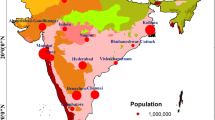Abstract
This chapter examines the spatiotemporal pattern of urbanization in Kathmandu Valley using remote sensing and spatial metrics techniques. The study is based on time series data compiled from satellite images acquired in the last four decades. A five-step hybrid technique is presented to create land use and land cover maps from remote sensing imagery. Urban built-up areas had a slow trend of growth in the 1960s and 1970s but have grown rapidly since the 1980s. The metrics of the urbanization process has confirmed that the landscape in the valley consists of fragmented and heterogeneous land use combinations. However, the refill type of development process in the city core and immediate fringe areas has shown a decreasing trend in the neighborhood distances between land use patches, and an increasing trend towards physical connectedness, which indicates a higher probability of homogenous landscape development in the upcoming decades.
This chapter is improved from ”Rajesh Bahadur Thapa and Yuji Murayama (2009), Examining spatiotemporal urbanization patterns in Kathmandu valley, Nepal: Remote sensing and spatial metrics approaches. Remote Sensing, 1, 534–556”.
Access this chapter
Tax calculation will be finalised at checkout
Purchases are for personal use only
Similar content being viewed by others
References
Abdullah, S. A., & Nakagoshi, N. (2006). Changes in landscape spatial pattern in the highly developing state of Selangor, Peninsular Malaysia. Landscape and Urban Planning, 77, 263–275.
Bruijn, C. A. D. (1991). Spatial factors in urban growth: Toward GIS models for cities in development countries. ITC Journal, 4, 221–231.
Eastman, J. R., Jiang, H., & Toledano, J. (1998). Multi-criteria and multi-objective decision making for land allocation using GIS. In E. Beinat & P. Nijkamp (Eds.), Multicriteria analysis for land-use management (pp. 227–252). Kluwer: Dordrecht
Gautam, R., Baral, S., & Herat, S. (2008). Opportunities and challenges in implementing pollution prevention strategies to help revive the ailing carpet manufacturing sector of Nepal. Resources, Conservation and Recycling, 52, 920–930.
Herold, M., Goldstein, N. C., & Clarke, K. C. (2003). The spatiotemporal form of urban growth: Measurement, analysis and modelling. Remote Sensing of Environment, 86, 286–302.
ICIMOD/UNEP. (2001). Kathmandu valley GIS database, CD-ROM. ICIMOD: Kathmandu.
Industrial Development Management. (2007). Present status. Retrieved September 12, 2008, from http://www.idm.com.np/presentstatus.php
Jensen, J. R. (2005). Introductory digital image processing: A remote sensing perspective. Upper Saddle River, NJ: Prentice Hall.
Li, X., & Yeh, A. G.-O. (2004). Analyzing spatial restructuring of land use patterns in a fast growing region using remote sensing and GIS. Landscape and Urban Planning, 69, 335–354.
Lillesand, T. M., Kiefer, R. W., & Chipman, J. W. (2008). Remote sensing and image interpretation. New York: Wiley.
McGarigal, K., Cushman, S. A., Neel, M. C., & Ene, E. (2002). FRAGSTATS: Spatial pattern analysis program for categorical maps. University of Massachusetts Amherst: Amherst, MA. Retrieved February 12, 2008, from http://www.umass.edu/landeco/research/fragstats/fragstats.html
Openshaw, S., & Alvandies, S. (1999). Applying geocomputation to the analysis of spatial distributions. In P. Longley, M. Goodchild, D. Maguire, & D. Rhind (Eds.), Geograhpic information systems: Principles and technical issues (pp. 267–282). Wiley: New York.
O’Neill, R. V., Krummel, J. R., Gardner, R. H., Sugihara, G., Jackson, B., DeAngelis, D. L. et al. (1988). Indices of landscape pattern. Landscape Ecology, 1, 153–162.
Seto, K. C., & Kaufmann, R. K. (2003). Modeling the drivers of urban land use change in the Perl River Delta, China: Integrating remote sensing with socioeconomic data. Land Economics, 79, 106–121.
Sharma, P. (2003). Urbanization and development. In Population monograph of Nepal (pp. 375–412). Kathmandu: Central Bureau of Statistics.
Thapa, R. B., & Murayama, Y. (2008). Spatial structure of land use dynamics in Kathmandu Valley. In J. Chen, J. Jiang, & A. Peled (Eds.), The international archives of the photogrammetry, remote sensing and spatial information sciences (Vol. XXXVII, (Part-B8), pp. 11–16). ISPRS: Beijing.
Thapa, R. B., & Murayama, Y. (2009a). Urban mapping, accuracy, & image classification: A comparison of multiple approaches in Tsukuba City, Japan. Applied Geography, 29, 135–144.
Thapa, R. B., & Murayama, Y. (2009b). Examining spatiotemporal urbanization patterns in Kathmandu valley, Nepal: Remote sensing and spatial metrics approaches. Remote Sensing, 1, 534–556.
Thapa, R. B., & Murayama, Y. (2010a). Remote sensing: Platforms and sensors. In B. Warf (Ed.), Encyclopedia of geography (pp. 2420–2424). Thousand Oaks, CA: SAGE
Thapa, R. B., & Murayama, Y. (2010b). Drivers of urban growth in the Kathmandu valley, Nepal: Examining the efficacy of the analytic hierarchy process. Applied Geography, 30, 70–83.
Thapa, R. B., Murayama, Y., & Ale, S. (2008). Kathmandu. Cities, 25, 45–57.
Thapa, R. B., & Murayama, Y. (2011). Urban growth modeling of Kathmandu metropolitan region, Nepal. Computers, Environment and Urban Systems, 35, 25–34.
Author information
Authors and Affiliations
Corresponding author
Editor information
Editors and Affiliations
Rights and permissions
Copyright information
© 2011 Springer Science+Business Media B.V.
About this chapter
Cite this chapter
Thapa, R.B., Murayama, Y. (2011). Spatiotemporal Patterns of Urbanization: Mapping, Measurement, and Analysis. In: Murayama, Y., Thapa, R. (eds) Spatial Analysis and Modeling in Geographical Transformation Process. GeoJournal Library, vol 100. Springer, Dordrecht. https://doi.org/10.1007/978-94-007-0671-2_15
Download citation
DOI: https://doi.org/10.1007/978-94-007-0671-2_15
Published:
Publisher Name: Springer, Dordrecht
Print ISBN: 978-94-007-0670-5
Online ISBN: 978-94-007-0671-2
eBook Packages: Earth and Environmental ScienceEarth and Environmental Science (R0)




